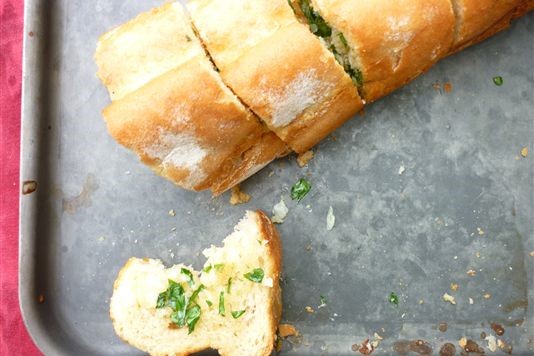Make it don't buy it: garlic bread

No movie and pizza night is complete without popping a garlic baguette into the oven. Yet why buy the supermarket stuff, when it’s so easy to make your own?
“Garlic? Bread? Not in my lifetime,” says Peter Kay in his famous sketch, mocking his father’s first incredulous encounter with a slice of the garlicky stuff. But Kay’s allium-averse dad is in the minority, with garlic bread now such a British supermarket staple that it is included in the annual inflation basket of goods.
European origins
 The garlic bread popular in Britain today – slices of baguette soaked through with garlicky butter – is most likely an amalgamation of several traditional European dishes. The Spanish have long made Pan a la Catalana, also called Pan con Tomate, a Catalan dish of toasted bread rubbed with ripe tomato and fresh garlic. In Italy, people have been making bruschetta (pictured here) since at least the 15th Century; a similar dish involving grilled bread rubbed with garlic, drizzled with olive oil and served with a variety of toppings. Its exact regional origins are uncertain, with Tuscany, Abruzzo and Umbria all laying claim to the dish.
The garlic bread popular in Britain today – slices of baguette soaked through with garlicky butter – is most likely an amalgamation of several traditional European dishes. The Spanish have long made Pan a la Catalana, also called Pan con Tomate, a Catalan dish of toasted bread rubbed with ripe tomato and fresh garlic. In Italy, people have been making bruschetta (pictured here) since at least the 15th Century; a similar dish involving grilled bread rubbed with garlic, drizzled with olive oil and served with a variety of toppings. Its exact regional origins are uncertain, with Tuscany, Abruzzo and Umbria all laying claim to the dish.
To the French we owe the baguette popular in the British version, with another nod across the pond to a company called Cole’s in Michigan, which claims to have manufactured the first frozen garlic bread in the 1970s.
From Elizabeth David to Pizza Express
 British wariness of garlic, as characterised by Peter Kay’s dad, and Mrs Beeton’s remarks that “the smell of this plant was generally considered offensive,” began to give way after food writer Elizabeth David popularised Mediterranean food in the mid 20th century. David’s efforts were followed by the bistro food boom in 70s Britain, and was compounded by cheap package holidays which exposed millions of Brits to garlic and other southern European delights.
British wariness of garlic, as characterised by Peter Kay’s dad, and Mrs Beeton’s remarks that “the smell of this plant was generally considered offensive,” began to give way after food writer Elizabeth David popularised Mediterranean food in the mid 20th century. David’s efforts were followed by the bistro food boom in 70s Britain, and was compounded by cheap package holidays which exposed millions of Brits to garlic and other southern European delights.
Many of us had our first taste of garlic bread at a chain like Pizza Hut or Pizza Express in the 80s or 90s, the latter offering the arguably posher garlic ‘dough balls’.
Make it, don’t buy it
 Ready-made garlic bread is often made with margarine and stuffed full of unpronounceable preservatives. It’s almost as cheap, almost as easy, and the results are a lot more delicious if you make your own with a fresh baguette. You could even go the whole hog, and make your own bread.
Ready-made garlic bread is often made with margarine and stuffed full of unpronounceable preservatives. It’s almost as cheap, almost as easy, and the results are a lot more delicious if you make your own with a fresh baguette. You could even go the whole hog, and make your own bread.
Ingredients
- 0.5 of a 400g baguette
- 2 large cloves fresh garlic, crushed
- 70 g softened, unsalted butter
- 2 tsp flat leaf parsley, finely chopped
- 1 pinch sea salt
- 0.5 of a 400g baguette
- 2 large cloves fresh garlic, crushed
- 2.5 oz softened, unsalted butter
- 2 tsp flat leaf parsley, finely chopped
- 1 pinch sea salt
- 0.5 of a 400g baguette
- 2 large cloves fresh garlic, crushed
- 2.5 oz softened, unsalted butter
- 2 tsp flat leaf parsley, finely chopped
- 1 pinch sea salt
Details
- Cuisine: British
- Recipe Type: Bread
- Difficulty: Easy
- Preparation Time: 5 mins
- Cooking Time: 15 mins
- Serves: 4
Step-by-step
- Preheat the oven to 180°C/160°C fan/Gas 4.
- Mash the crushed garlic and the softened butter together in a bowl with the back of a spoon, before stirring the finely chopped flat-leaf parsley into the mixture. Add a little sea salt to season.
- Using a bread knife, cut the baguette in half (you can prepare both halves of the baguette if you are serving lots of people, or save the other half).
- Cut slits 4cm apart along the baguette, cutting three quarters of the way down but without slicing all the way through, so your baguette remains intact.
- Use a teaspoon to fill the slits with the butter mixture. Wrap loosely in foil and place on a baking tray and bake for 10 minutes. Open the top of the foil and cook for a further five minutes until the bread is golden and the butter has sunk into the crumb.
You may also like
Comments
Do you want to comment on this article? You need to be signed in for this feature